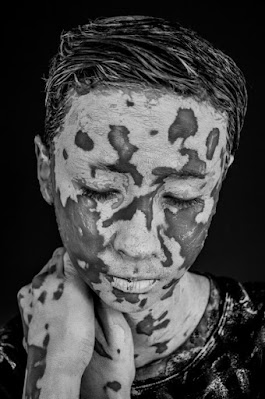VITILIGO
Vitiligo is a skin disorder that causes
white skin patches where the skin's colour has been lost. It happens when the
cells that make melanin, the pigment that gives skin, hair, and eyes their
colours, are damaged or cease to function effectively. Vitiligo not only
depends on genetic and autoimmune factors but also environmental factors.
People of all ages, genders, and
ethnicities can develop vitiligo, but those with darker skin tones will detect
it more readily. Although the disorder is not contagious or lethal, it can
significantly affect personal life and self-esteem. Vitiligo and stress are associated to each other.
This ailment causes no physical pain but more an emotional and psychological discomfort, particularly if the patches are noticeable and conspicuous.
There is no known cure for vitiligo at
this time, but there are several treatment options available to help control
the condition and enhance the skin's look. Treatment options may include:
1. Topical corticosteroids: These
ointments help to reduce inflammation and cause skin repigmentation.
2. Topical calcineurin inhibitors:
Tacrolimus and pimecrolimus are medications that can be used to control the
immune response and encourage repigmentation.
3. Psoralen plus ultraviolet A (PUVA)
therapy is taking psoralen, a medicine that increases skin sensitivity to
light, and then exposing the afflicted areas to ultraviolet A (UVA) light.
4. Narrowband ultraviolet B (NB-UVB)
therapy: To encourage repigmentation, the skin is exposed to a specific
wavelength of ultraviolet B (UVB) radiation.
5. Excimer laser: This targeted laser
therapy targets the afflicted areas with a focused beam of UVB light,
facilitating repigmentation.
6. Depigmentation: In circumstances where
vitiligo affects a considerable area of the skin, some people may choose to
lighten the unaffected skin to achieve a more uniform appearance.
It is vital to remember that therapy
success varies depending on the individual and the severity of the ailment.
Furthermore, controlling vitiligo entails protecting the skin from the sun by
applying sunscreen and avoiding excessive sun exposure, as depigmented areas
are more vulnerable to sunburn.
If you have vitiligo or suspect you may
have it, consult a dermatologist to assess your condition and prescribe the
best treatment choices for you. They will also be able to offer advice and
assistance to help you deal with the emotional and psychological aspects of
having vitiligo.


Comments
Post a Comment